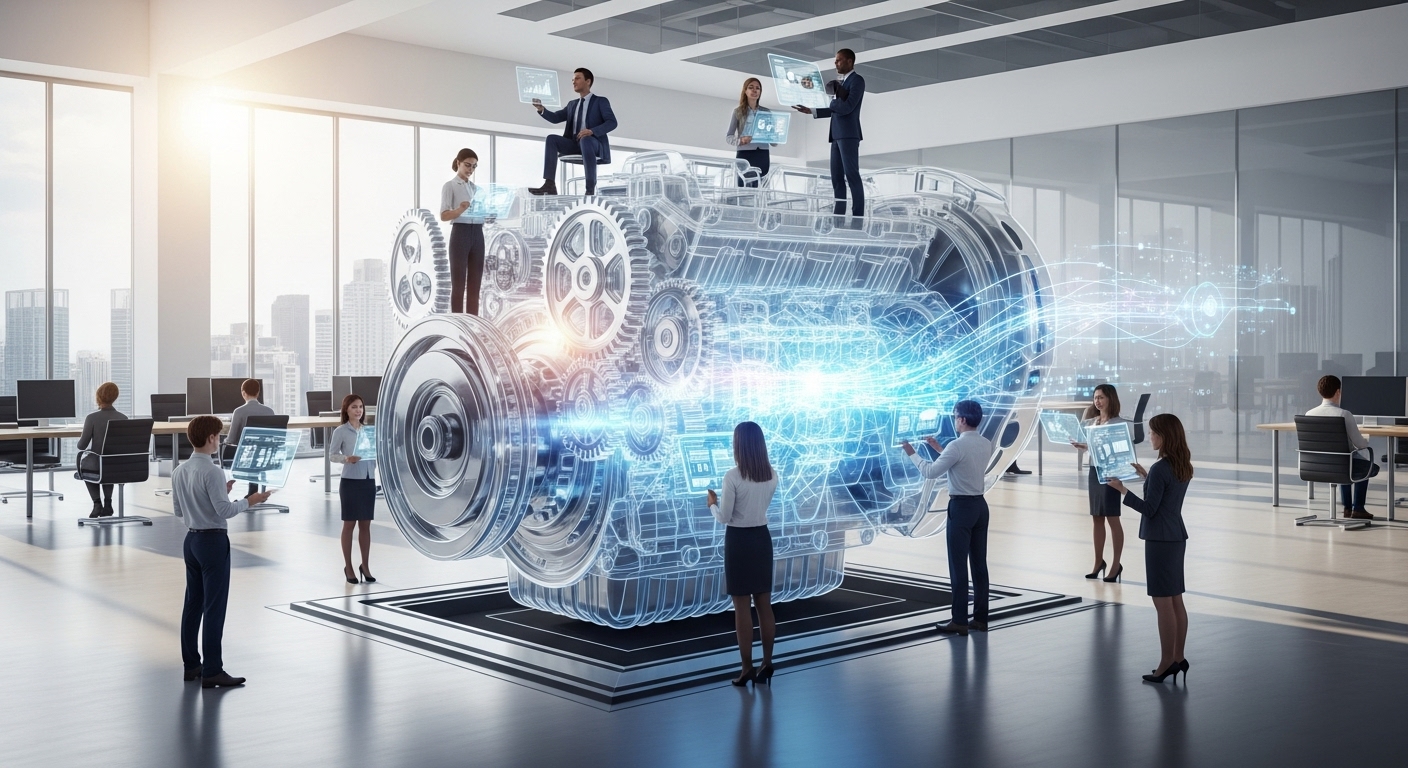In today’s volatile business environment, the traditional view of operational efficiency as a one-time project or a static set of best practices is dangerously outdated. Chasing peak performance through rigid, top-down mandates often leads to brittle systems that shatter under unexpected pressure. The true competitive advantage lies not in achieving a fixed state of efficiency, but in building an organization that can learn, adapt, and improve in real-time. This requires a fundamental shift in thinking: from building a perfect machine to cultivating an ‘adaptive engine.’ This is a self-correcting system where technology, processes, and people work in a continuous feedback loop, proactively identifying friction and optimizing workflows. This article will provide a blueprint for constructing this adaptive engine, exploring how to diagnose core inefficiencies, leverage technology for real-time feedback, design modular processes, empower your teams to steer the system, and ultimately, foster a culture where continuous improvement is simply how work gets done.
Diagnosing the Drag: Identifying Your Core Inefficiency Indicators
Before you can build a self-correcting system, you must first understand where energy is being wasted. This requires a diagnostic approach that goes far beyond surface-level financial metrics. While profit and loss statements tell you the outcome, they don’t reveal the operational friction causing the drag. The first step is to identify your core inefficiency indicators, which act as the engine’s warning lights. These can be broken down into several key areas. Process cycle time—the total duration from the start to the end of a process—is a fundamental metric. A lengthy cycle time often points to hidden bottlenecks, unnecessary handoffs, or wait states. Throughput, or the amount of work completed in a given period, measures the engine’s output capacity. A low or inconsistent throughput suggests constraints that are throttling performance. Another critical indicator is the error rate. High error rates not only incur direct costs for rework but also signify underlying issues in training, process clarity, or technology. Finally, resource utilization metrics reveal whether your assets—be it machinery, software licenses, or human capital—are being used effectively. To uncover these indicators, businesses are increasingly turning to tools like process mining, which uses event log data from IT systems to create a visual map of how processes are actually executed, exposing deviations from the ideal path. Value Stream Mapping (VSM) serves a similar purpose, helping teams visualize and analyze the flow of materials and information required to bring a product or service to a customer. By focusing on these leading indicators, you shift from reacting to past failures to proactively tuning your operational engine for future performance.
The Technology Flywheel: Leveraging AI and Automation for Real-Time Feedback
An adaptive engine thrives on data, and modern technology is the key to creating the powerful, real-time feedback loops necessary for self-correction. The goal isn’t merely to automate tasks but to build a technology ‘flywheel’ where automated execution generates data, which in turn fuels intelligent analysis, leading to smarter adjustments. Robotic Process Automation (RPA) can handle repetitive, rule-based tasks in finance or HR, but its true value is unlocked when each action is logged and analyzed to spot patterns or exceptions. In manufacturing and logistics, Internet of Things (IoT) sensors embedded in machinery and inventory can stream constant data on performance, temperature, or location. This data feeds into predictive maintenance algorithms, allowing teams to fix equipment before it breaks, preventing costly downtime. Artificial intelligence and machine learning are the analytical core of this flywheel. AI-powered dashboards can sift through millions of data points from sales, customer service, and operations to provide a holistic, real-time view of business health. This replaces static weekly or monthly reports with a live, dynamic command center. As one operations director noted:
‘We used to spend the first two days of the week figuring out what happened last week. Now, we know what’s happening this second, and we can spend our time deciding what to do next.’
This immediacy is crucial; it shortens the gap between event and response, allowing the organization to adjust to changing conditions—like a supply chain disruption or a sudden spike in customer demand—in hours instead of weeks. This technology stack doesn’t replace human decision-making; it supercharges it with timely, accurate, and actionable intelligence.
Process Architecture: From Rigid Blueprints to Modular Workflows
The traditional approach to process design often resembles creating a rigid, monolithic blueprint. Every step is meticulously planned and interlocked, which works well in a stable environment but becomes a significant liability when change is required. A single alteration can cause a cascade of disruptions, making the organization slow and resistant to innovation. The adaptive engine requires a new process architecture built on principles of modularity and composability. Think of it as the difference between carving a sculpture from a single block of marble and building it with LEGO bricks. In a modular system, complex workflows are broken down into smaller, independent services or components that can be individually modified, replaced, or reconfigured without overhauling the entire process. This approach is heavily enabled by technologies like Application Programming Interfaces (APIs), which allow disparate software systems to communicate and exchange data seamlessly. For example, a customer onboarding process could be composed of separate modules for identity verification, credit checking, and account setup. If the company decides to switch to a new identity verification provider, it only needs to swap out that one ‘brick’ via its API, leaving the rest of the workflow untouched. This ‘composable enterprise’ model provides immense strategic agility. It allows businesses to rapidly assemble new services, experiment with different process variations, and integrate new technologies with minimal friction. This architectural flexibility is fundamental to a self-correcting system because it lowers the cost and risk of making changes, encouraging the very experimentation and iteration that drive continuous improvement.
Human-in-the-Loop: Empowering Teams to Steer the Engine
Technology and processes form the chassis of the adaptive engine, but it’s your people who provide the steering, intuition, and creative problem-solving. A common mistake in the pursuit of efficiency is attempting to automate human expertise out of the system. A truly adaptive organization practices a ‘human-in-the-loop’ philosophy, recognizing that front-line employees are the most sensitive sensors for detecting operational anomalies and opportunities for improvement. They are the ones who experience the friction of a poorly designed workflow or the frustration of an inadequate tool. Empowering them to act on these insights is critical for the engine’s self-correction mechanism. This empowerment begins with creating a culture of psychological safety, where team members feel secure enough to flag problems, question established procedures, and propose new ideas without fear of blame. Frameworks like Kaizen are built on this principle, promoting the idea that small, continuous improvements from everyone are more powerful than occasional, large-scale overhauls from management. To facilitate this, leaders must provide teams with both the authority and the tools to make changes. This includes access to relevant performance data, training in problem-solving methodologies like the ‘5 Whys’ or A3 thinking, and a clear, streamlined process for escalating ideas that require broader support or resources. When employees see their suggestions being listened to and implemented, it creates a powerful virtuous cycle. They become more engaged, more observant, and more invested in the operational health of the business, transforming from passive cogs in a machine to active drivers of the adaptive engine.
The Kaizen Cadence: Implementing Rituals for Continuous Improvement
An adaptive engine doesn’t improve by chance; it improves by design. This requires establishing a consistent rhythm, or cadence, of review and refinement. Just as an engine needs regular tune-ups, your operations require structured rituals dedicated to continuous improvement. Without this cadence, improvement efforts become sporadic, reactive, and often forgotten amidst the pressures of daily work. The Japanese concept of Kaizen, or continuous improvement, provides a powerful model for these rituals. The goal is to make the act of improving the process as routine as executing the process itself. This can take many forms depending on the team and context. Daily stand-up meetings, common in agile software development, can be adapted for any team to quickly discuss what’s working, what’s not, and what roadblocks exist. This creates a tight, daily feedback loop. Weekly process retrospectives offer a dedicated time for teams to step back and analyze performance data from the past week, identify a specific problem area, and brainstorm small, testable improvements. Monthly deep dives can tackle more complex, cross-functional challenges that require more significant analysis and planning. The key to this cadence is a bias for action and experimentation. Rather than spending months designing a ‘perfect’ solution, teams are encouraged to implement small changes, measure their impact, and then iterate. This A/B testing approach to operations de-risks innovation and accelerates learning. By embedding these rituals into the organizational calendar, you transform continuous improvement from a lofty corporate goal into a tangible, practiced, and persistent habit.
Measuring Momentum: Shifting from Output Metrics to Impact and Adaptability
The final component of an adaptive engine is a modern approach to measurement. If you’re building a system designed for adaptability and resilience, you can’t measure its success using only traditional, static output metrics. While metrics like units produced, sales closed, or tickets resolved are important, they only measure the engine’s speed on a straight, predictable road. They don’t tell you how well it can navigate corners, handle rough terrain, or adapt to a new destination. To truly gauge the health and effectiveness of your adaptive engine, you must supplement output metrics with measures of momentum and adaptability. One such metric is ‘Time to Resolution’ for novel problems—how quickly can the organization detect, diagnose, and solve an issue it has never seen before? A decreasing time-to-resolution indicates a growing organizational muscle for problem-solving. Another key metric is the ‘Rate of Successful Process Experiments,’ which measures how many improvement hypotheses are tested and lead to positive outcomes. This tracks the engine’s learning velocity. Furthermore, you can measure employee engagement in improvement initiatives through participation rates in Kaizen events or the number of actionable suggestions submitted. This gauges the health of your operational culture. By focusing on these second-order metrics, you shift the definition of success from ‘doing the same thing faster’ to ‘getting better at getting better.’ This is the ultimate proof that your adaptive engine is working: it is not only performing efficiently today but is structurally engineered to perform even more efficiently tomorrow, regardless of what challenges arise.
In conclusion, the pursuit of operational efficiency has evolved. It is no longer a static target achieved through rigid controls but a dynamic capability built on the principles of adaptation and continuous learning. Building an adaptive engine is a holistic endeavor that weaves together insightful diagnostics, intelligent technology, modular process architecture, and an empowered human workforce. It starts with a deep diagnosis to identify true inefficiency indicators, moving beyond simplistic financial reports. It then leverages a technology flywheel of AI and automation to create the real-time feedback loops essential for rapid correction. This is supported by a flexible, composable process architecture that allows for swift change without systemic disruption. Critically, this entire system is steered by empowered employees, whose insights are harnessed through a disciplined cadence of improvement rituals. Ultimately, success is measured not just by current output, but by the organization’s demonstrated capacity to adapt and improve. Shifting from a static machine to a living, self-correcting engine is the definitive strategic imperative for leaders who want to build resilient, high-performing organizations that can thrive amidst the uncertainty of the future.





